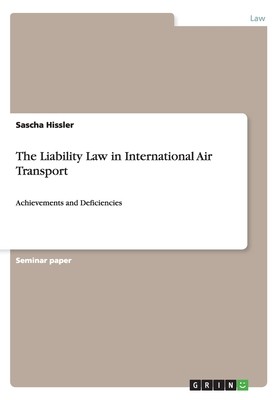
- We will send in 10–14 business days.
- Author: Sascha Hissler
- Publisher: GRIN Verlag
- Year: 2009
- Pages: 20
- ISBN-10: 3640391020
- ISBN-13: 9783640391028
- Format: 17.8 x 25.4 x 0.1 cm, softcover
- Language: English
- SAVE -10% with code: EXTRA
Reviews
Description
Seminar paper from the year 2009 in the subject Law - Comparative Legal Systems, Comparative Law, grade: 1,3, University of Applied Sciences Wildau (Wildau Institute of Technology (WIT)), course: Aviation Management, language: English, abstract: Law in general is subdivided in two parts: in public law and in private law. Public law governs the relationship between individuals and the states whereas private law regulates the relationship between individuals. When it comes to the laws ruling the aviation world, we also have to divide into these two parts: the public international air law represented in general by the Chicago Convention (formally "The Convention on International Civil Aviation" done at Chicago on 7 December 1944) and on the other side the private international air law, mainly represented through the Montreal Convention (formally "Convention for the Unification of Certain Rules for the International Carriage by Air"). The latter represents the liability law in international air transport, regulating the relationship between an air carrier and its customer, passenger, consignor or cargo shipper. It is supposed to replace the Warsaw Convention of 1929 which sets compensation levels for victims of air accidents, as well as liability for damage, delay or loss of baggage and cargo. This paper describes first the historical way the Convention developed from Warsaw to Montreal and then goes into detail of the Montreal Convention with its achievements and deficiencies. By quoting from the original, it is written very close to the wording of the Convention, emphasizing the parallels and differences of the Warsaw and the Montreal Convention. Structuring: Abbreviations Introduction History The Warsaw System The Montreal Convention 1999 Achievements Deficiencies Conclusion Literature Internet-Sources
EXTRA 10 % discount with code: EXTRA
The promotion ends in 18d.10:56:58
The discount code is valid when purchasing from 10 €. Discounts do not stack.
- Author: Sascha Hissler
- Publisher: GRIN Verlag
- Year: 2009
- Pages: 20
- ISBN-10: 3640391020
- ISBN-13: 9783640391028
- Format: 17.8 x 25.4 x 0.1 cm, softcover
- Language: English English
Seminar paper from the year 2009 in the subject Law - Comparative Legal Systems, Comparative Law, grade: 1,3, University of Applied Sciences Wildau (Wildau Institute of Technology (WIT)), course: Aviation Management, language: English, abstract: Law in general is subdivided in two parts: in public law and in private law. Public law governs the relationship between individuals and the states whereas private law regulates the relationship between individuals. When it comes to the laws ruling the aviation world, we also have to divide into these two parts: the public international air law represented in general by the Chicago Convention (formally "The Convention on International Civil Aviation" done at Chicago on 7 December 1944) and on the other side the private international air law, mainly represented through the Montreal Convention (formally "Convention for the Unification of Certain Rules for the International Carriage by Air"). The latter represents the liability law in international air transport, regulating the relationship between an air carrier and its customer, passenger, consignor or cargo shipper. It is supposed to replace the Warsaw Convention of 1929 which sets compensation levels for victims of air accidents, as well as liability for damage, delay or loss of baggage and cargo. This paper describes first the historical way the Convention developed from Warsaw to Montreal and then goes into detail of the Montreal Convention with its achievements and deficiencies. By quoting from the original, it is written very close to the wording of the Convention, emphasizing the parallels and differences of the Warsaw and the Montreal Convention. Structuring: Abbreviations Introduction History The Warsaw System The Montreal Convention 1999 Achievements Deficiencies Conclusion Literature Internet-Sources


Reviews